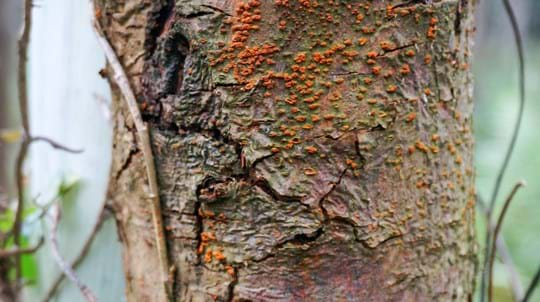
Pests and diseases
Sweet Chestnut Blight
A fungus that attacks sweet chestnut.
Forestry Commission
The Forestry Commission England’s (FC) Tree Health team plays an important role in the protection of England’s trees, woods and forests. As a Tree Health Officer, I work with a range of colleagues from FC and our partner organisations to deliver a pro-active response to any reported outbreaks and the consistent day-to-day management of established pests and diseases.
The Tree Health team carries out specialist surveillance for existing threats and monitors for emerging tree health concerns during the summer months when the tree crowns can be easily observed from the air.
This year, we returned from the Christmas break to investigate the new finding of a high-priority disease, Cryphonectria parasitica, in Devon. Commonly known as sweet chestnut blight (SCB), this is a particularly nasty fungus which originates from Asia but is now widespread in continental Europe. Due to the quarantine nature of this disease, we needed to work out where the disease had come from, how it had arrived here and how many trees were affected.
Working with the nursery sector, we were able to determine whether those saplings sold around the same time as the infected trees would need to be ‘traced forward’ and to identify areas for other follow-up surveys. These subsequent inspections formed the basis of our work for the next 2 months. Where disease was confirmed, the Tree Health team then instigated both 1km and 5km radial surveys of neighbouring sweet chestnut trees to determine whether the infection had spread out to trees in the wider environment.
We are still surveying sweet chestnut in the area with Tree Health officers working to inspect recently planted trees in our own local areas. We would be grateful if you could look out for any signs of ill-health in Sweet chestnut locally and report via the Tree Alert website. Use the FC symptoms factsheet to help check what you are looking for.
As with many fungal pathogens, sweet chestnut blight can be found in soil, organic material and water. If this material is moved from place to place, diseases can be spread. The Forestry Commission recommends that everyone, whether a forester, arborist, or a woodland visitor, undertakes good biosecurity. By simply removing soil and organic material from boots, bikes, and tools between sites and visits, we can reduce the risk of spreading harmful diseases. The FC’s ‘Keep it Clean’ biosecurity campaign provides more information.